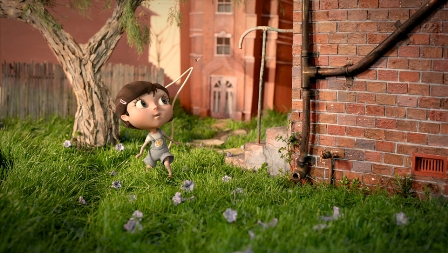It doesn’t seem that long ago that 3D computer animation was more expensive than stop-motion photography. But for director Simon Rippingale, it was the high-cost of stop-motion that led him to use 3D animated characters within his handmade miniature sets for his short film A Cautionary Tail.
Thankfully for Rippingale, the two media types have married up perfectly to give A Cautionary Tail a visually-rich backdrop for its story of loss and rediscovery. Rippingale says the use of stop-motion was intended to provide the 13-minute film with an ‘earthy’ look.
“I knew I didn’t want to do a completely CGI film,” Rippingale says. “I love building and making, and the imperfections that come as part of that, which are lovely on camera. But with the budget that we had, I knew that we would only have one take on any shot.”
The compromise was to shoot the handcrafted sets and then insert digitally-animated characters, with careful use of lighting and high-dynamic range indexing to provide a solid reference for the compositors. This reduced the total studio shoot to just five days. A small team of animators at Hackett Films then worked for three months to bring the characters to life using Autodesk’s 3D animation software, Maya. Compositing was completed at Heckler studio using The Foundry’s compositing tool, NUKE.
Rippingale says the most difficult part of the process was matching the positioning of the cameras between the live-action miniatures and the 3D animations.
“We were quite meticulous,” says Rippingale. “It was tempting to gloss over things because we were on a tight schedule. But we had to be disciplined and it helped a lot because if you are guessing the cameras it breaks your ‘eye’ a bit.”
He was also hamstrung by being unable to move the camera when creating the 3D animation – something he could have done easily had the sets also been created in 3D.
“I tried to keep the camera movements to a minimum,” he says. “We used the motion-control rig for a few shoots, but it slowed down the shoot a lot.”
The film uses 21 miniature sets which were handcrafted over four months by Rippingale and a team of four, including senior model maker Simon Bethune. One features a tray of soil and grass the size of a queen bed.
“I tried to use as much real material as possible,” Rippingale says. “We wanted to have that tactile warmth, and it plays well off the 3D.”
A professional illustrator, Rippingale also teaches film and animation subjects at the Enmore Design School. He has prior experience with stop-motion animation, including working with A Cautionary Tail’s producer Pauline Piper on the 2006 Gillian Armstrong documentary Unfolding Florence.
The inspiration for A Cautionary Tail came from his close friend, writer Erica Harrison. A promising runner in her junior years, Harrison was involved in a serious car accident four years ago that at one point looked likely to result in her losing a leg.
Harrison says running had been her passion and a huge part of her identity, but after the car accident she was left wondering if she would ever walk again. Today she walks unassisted.
“I wrote the story during that period of rehabilitation,” Harrison says. “It’s a parable about the loss and rediscovery of magic, and the feeling that I didn’t know who I was any more and everything wonderful had been lost. And the process of writing the story and the theme of the story was about rediscovering that magic.”
A Cautionary Tail is Harrison’s first screenwriting project, having previously worked as a journalist and photographer. The story was originally written as a poem in a style inspired by the dark wit of Roald Dahl, but Rippingale convinced her to adapt it for the screen.
The project was also fortunate to attract A-list vocal talent, including David Wenham as the narrator, along with Cate Blanchett and Barry Otto. Rippingale says his technique was simply to ask them.
“I really wanted to work with David Wenham because I think he has that humour and warmth in his voice that was perfect for this,” Rippingale says.
“He was the first person that we asked to narrate, and he said yes. And then we thought let’s send it to Cate Blanchett’s agent, thinking she would say no. And then she said yes.”
Initial funding was secured through Screen NSW, and the project also raised more than $50,000 through the Kickstarter crowdfunding site.
Rippingale says he would happily explore using mixed media again for future projects.
“It’s a nice technique that’s an art form in itself,” he says. “I’d like to develop the technique of melding the worlds together. It’s got real potential to do beautiful stuff.”
This article originally appeared in IF Magazine #149 (October-November 2012). In December 2012, A Cautionary Tail received Screen Australia funding to make the short into an interactive app for tablets. The short also featured on the ABC's 7.30 Report this year – video can be found here.
A Cautionary Tail trailer from RAWR Media on Vimeo.


